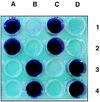Isolation of an Escherichia coli K-12 mutant strain able to form biofilms on inert surfaces: involvement of a new ompR allele that increases curli expression
- PMID: 9573197
- PMCID: PMC107187
- DOI: 10.1128/JB.180.9.2442-2449.1998
Isolation of an Escherichia coli K-12 mutant strain able to form biofilms on inert surfaces: involvement of a new ompR allele that increases curli expression
Abstract
Classical laboratory strains of Escherichia coli do not spontaneously colonize inert surfaces. However, when maintained in continuous culture for evolution studies or industrial processes, these strains usually generate adherent mutants which form a thick biofilm, visible with the naked eye, on the wall of the culture apparatus. Such a mutant was isolated to identify the genes and morphological structures involved in biofilm formation in the very well characterized E. coli K-12 context. This mutant acquired the ability to colonize hydrophilic (glass) and hydrophobic (polystyrene) surfaces and to form aggregation clumps. A single point mutation, resulting in the replacement of a leucine by an arginine residue at position 43 in the regulatory protein OmpR, was responsible for this phenotype. Observations by electron microscopy revealed the presence at the surfaces of the mutant bacteria of fibrillar structures looking like the particular fimbriae described by the Olsén group and designated curli (A. Olsén, A. Jonsson, and S. Normark, Nature 338:652-655, 1989). The production of curli (visualized by Congo red binding) and the expression of the csgA gene encoding curlin synthesis (monitored by coupling a reporter gene to its promoter) were significantly increased in the presence of the ompR allele described in this work. Transduction of knockout mutations in either csgA or ompR caused the loss of the adherence properties of several biofilm-forming E. coli strains, including all those which were isolated in this work from the wall of a continuous culture apparatus and two clinical strains isolated from patients with catheter-related infections. These results indicate that curli are morphological structures of major importance for inert surface colonization and biofilm formation and demonstrate that their synthesis is under the control of the EnvZ-OmpR two-component regulatory system.
Figures







References
-
- Bardonnet N, Blanco C. uidA antibiotic resistance cassettes for insertion mutagenesis, gene fusions and genetic constructions. FEMS Microbiol Lett. 1992;93:243–248. - PubMed
-
- Berlyn M K B, Low K B, Rudd K E. Linkage map of Escherichia coli K-12, edition 9. In: Neidhardt F C, Curtiss III R, Ingraham J L, Lin E C C, Low K B, Magasanik B, Reznikoff W S, Riley M, Schaechter M, Umbarger H E, editors. Escherichia coli and Salmonella: cellular and molecular biology. 2nd ed. Washington, D.C: American Society for Microbiology; 1996. pp. 1715–1902.
-
- Caldwell D E, Korber D R, Lawrence J R. Confocal laser microscopy and digital image analysis in microbial ecology. Adv Microb Ecol. 1992;12:1–67.
Publication types
MeSH terms
Substances
LinkOut - more resources
Full Text Sources
Other Literature Sources
Molecular Biology Databases

